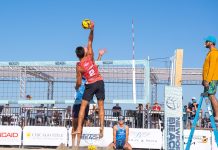I’ve been boating for more than 60 years in Newport Harbor. Many years the month of October features summer-style weather with less bay traffic, the air seems cleaner and the fishing continues the August-September seasonal high catch rates. We are enjoying one of the best late October seasons I can ever recall. The high-70s waterfront temperatures of last weekend seemed like a Fourth of July weekend at its finest.
Saturday’s paddleboard event at the Dunes Resort had a turnout in the hundreds. The volume of people paddling and enjoying the music and food will ensure future events. From youngsters to the elderly, all ages can and do enjoy kayaking and paddling all over our harbor. For the boaters, I request we be ever vigilant staying clear of the paddlers. Many are novices and may not have honed or learned the “rules of the road” that boaters have.
This leads me into a very important and serious subject. My past includes working around civilian and military aircraft, tugboats and pile-driving floating barges, commercial fishing boats, sail and power boats. Throughout my time around these potentially dangerous machines, my tutors preached forethought for safety.
I hope for those that may be in a teaching position, especially non-professionals, safety is your No. 1 concern. It is mine! The last few summers I have been instructing the young adult children of the owners of a 50-foot Hatteras sportfisher. The safe operation of this vessel is my primary mission and challenge.
I started from the beginning, asking the brother and sister what is the most important item in boating? Every time I would see them the first word I spoke was the same question. The most important part of boating is safety. The second most important part of boating is having a good time.
Throughout my lifetime of boating, and time around airplanes, I have witnessed many, many accidents and unplanned events.
An inexperienced group of four men in a 20-foot day cruiser, designed for lakes and the river, picked up the worst mooring in Avalon, beside us, in the late ’70s. There was 15 to 20 feet of kelp surrounding the mooring buoy. When we saw them starting for the buoy we were wondering what they were thinking. It seemed crazy to us!
One of the men grabbed too much of the kelp to pull them to the buoy, and it pulled him into the water. He never came up. We radioed the Harbor Master, but it was too late. As they arrived they asked the other three if they knew how to swim. None of them did, and they were immediately instructed to put on their lifejackets.
This is a sobering true story about an accident which, like most accidents, was preventable.
During my time around airplanes several accidents included loss of life. These were also preventable. Thank God the accidents I was around in pile driving and heavy marine construction only included loss of fingers and broken bones.
I personally have fallen in the bay while boating and working. Normally it has been in the winter when the air and water are cold. Thank goodness these events did not harm me. I’ve seen other people fall overboard, crash boats and get tangled in sailboat lines many times. A few times this involved alcohol, but most times these were seasoned boaters and workers with well-trained minds that were sober and intelligent.
As with airplane landings, the best voyage is one where everyone walks off the boat in the same condition as when they boarded. This is the most important part of all boat trips. While I am not a licensed vessel captain, hence the “skipper” term, when any skipper steps aboard any boat, any size, that person figuratively and legally automatically becomes the captain of that boat.
It is the captain’s primary responsibility to make sure that their voyage is a safe voyage!
Let’s move on. About a month ago we were on Sundance as a support vessel for the historic Jetlev jet pack voyage from Balboa to Avalon. We launched the high-speed 12-foot inflatable from its berth atop the bow deck and towed it so a spare Jetlev vessel could be stowed in case it was needed. We also had four large gas containers stowed in the cockpit. Ron, one of the three yacht owners and three friends, Judy and I and about 10 photographers and TV cameramen were also aboard.
The rough ocean conditions were unexpected and the flight to Catalina took Dean O’Malley about twice as long as he had hoped and planned. Thus, we needed to refuel the Jetlev mid-channel. We were “dead in the water” in 15 knots of wind, 2-f to 3-foot wind chop and 4- to 5-foot swells. In these conditions our 50-foot yacht was rockin’ and rollin’ feverishly. Most of our guests became seasick due to the conditions and activity.
The two support inflatables that closely followed the Jetlev came over to transfer the fuel containers. It took them two trips. In those kind of conditions and with 10 or more cameramen scrambling all over the cockpit for the best shot, there was chaos everywhere. Upon completion and checking that everyone was ready to proceed I, the captain, engaged the transmissions to forward and quickly entangled the tow line of our inflatable around the port propeller and drive shaft.
Uh-oh!
As I’m running out of space, I will say that in about 20 minutes we were secure enough to run on one engine to Avalon, where Ron and a guest free-dove and two hours later allowed us to use both engines back to Newport.
Sea Ya!
Skipper Steve
Steve Barrett is a yacht and marine construction consultant and can be reached at skipperstevetoo@yahoo.com.




